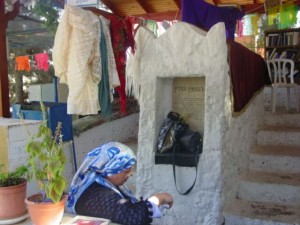CHARITY AND RIGHTEOUSNESS
by Chana Katz
The tomb of Benyamin HaTzadik is one of Tzfat’s more colorful gravesites. It is also the most homey.
The cinammon-red oriental rugs, decorative head scarfs draped around the walls and electric urn perking to provide the visitor with a hot drink combine to create a special warm feeling.
It seems a most appropriate tribute for this Mishnaic sage, a disciple of Rabbi Akiva. It was his unselfish giving from his own personal funds that sustained a desperately poor woman and her seven children.
The Talmud tractate “Bava Basra” relates this dramatic saga, taking today’s reader back almost a thousand years ago to the days when Benyamin HaTzaddik was administrator over the community charity fund.
“Parnaseni!” – Provide for me!” came a woman’s heartwrenching plea, as she approached the tzaddik for sustenance.
Unfortunately, a famine endured, and times were very bad.
“I swear in the name of the Holy Temple that there is nothing left in the charity fund,” Benyamin sadly told her. (In those days they did not swear in G-d’s name!).
But the woman persisted and told him of her dire plight, concluding that if he could not help her “a woman and her seven sons will perish!”
Moved by her plea, Benyamin offered her money from his own personal funds.
His selfless, life-sustaining assistance took place on earth but, the Talmud relates, the heavens clearly took notice.
Years later when Benyamin was very ill and near death, an angel arose in the heavenly courts and argued in his behalf: “If a person saves one life, it is as if he saved a whole world. How much more so that he sustained this woman and her seven children. How can such a man’s life be cut so short?”
The decree was cancelled and 22 years were added to Benyamin’s life.
A short version of this story is actually etched into granite on the side of Benyamin’s gravesite, which is located just a few minutes from the heart of Tzfat, one block southeast of the city’s landmark coffee factory and directly across the street to the south of the city’s vocational school.
The tombsite itself is identifiable by the multi-colored banners flapping in the breeze under a fairly new wooden pavilion. Just the other day, a worker was putting finishing touches on the seven steps leading up the grave, which were just rebuilt and widened to make passage easier.
At the south end of the site a picture is hung on the wall depicting Rabbi Shimon Bar Yochai as he was hiding in his cave for 13 years, fleeing the Roman soldiers and penning the most famous work explaining the mystical aspects of the Torah, the Zohar.
Plenty of holy books fill the shelves and every Friday afternoon a minyan prays at this site, welcoming the Shabbos Queen earlier than most other Tzfat minyans.
Its location off a main road makes access easy, yet that it is setback on a side-street across from a tree-filled lot provides a peaceful location for anyone to stop by and pray or say Tehillim (Psalms).
It is taught in Kabbala that while the soul ascends to greater spiritual levels once it is free from the restrictions of the body, a certain level or aspect of the soul remains at its bodily resting place.
It’s further said that a tzaddik has the merit to help our own personal prayers ascend on high. How much that teaches us about our actions in this world and their effect in the upper worlds!
And how much more so the large metal tzedaka boxes at Benyamin’s gravesite — and his own personal story — remind us of the importance of giving charity
~~~~~~~~~~~~~~~~~~~
Chana Katz, a former South Florida journalist, lives in Tsfat. Her articles on life in Israel have reached publications throughout the world.

